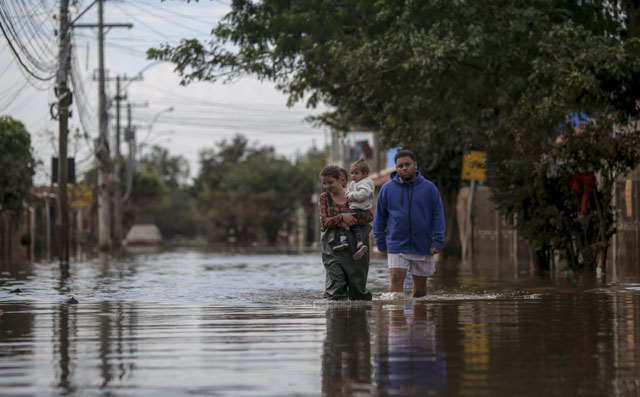
TRAVESSEIRO, Brazil, May 24, 2024 (BSS/AFP) - It was 6:00 in the morning when
Brazilian farmer Vernei Kunz heard the roar of water as the Forqueta river
overflowed its banks and swept away most of his 5,000 pigs.
Kunz, 60, has been farming for the past 42 years in the town of Travesseiro,
one of hundreds devastated by weeks of cataclysmic flooding that killed more
than 160 people in the southern state of Rio Grande do Sul.
"The sows and piglets were all in the sheds," he told AFP of the morning of
May 2.
"We opened the doors to let them out. We managed to grab some that were
swimming in the water. We pulled them out and brought them to the road, where
they were safe."
Kunz and his workers managed to save about 700 pigs, he said. The
slaughterhouse he works with collected them and is sending them to other
farms in the region.
"The rest drowned," said Kunz, pointing to piles of rubble that used to be
concrete-and-metal sheds.
A foul smell fills the air, a pungent reminder of the pigs still buried
beneath the mud three weeks later.
- 'Burn it all' -
The river, about 500 meters (yards) from Kunz's property, swelled as
torrential rains pounded the region in late April.
It finally burst its banks with a vengeance, sweeping up virtually everything
in its path, including the bridge into Travesseiro.
Today, only the two ends of the nearly 20-meter-high bridge remain, suspended
in the air.
Kunz laid off his 12 employees the same day with severance pay, he said.
Without any insurance coverage, he estimates his losses at between 10 million
and 15 million reais ($2 million to $3 million).
Overall, the agricultural sector -- the engine of the region's economy --
lost around $430 million, according to the National Confederation of
Municipalities.
The pig farmers' association for Rio Grande do Sul, one of Brazil's biggest
producers and exporters of pork, said the devastation affected between 25 and
28 percent of production.
"I had been through big floods before in 2010, but nothing like this," said
Kunz.
"That time, we could rebuild. This time, the water destroyed everything."
Experts say the intensity of the floods was linked to climate change.
"You can't go against nature," said Kunz, still wearing galoshes.
His property, which spans several thousand square meters, is littered with
twisted metal, aluminum sheets, pieces of walls and tree trunks.
"I'll have to burn it all. What else can I do?" he said.
His son, Eduardo, 34, explains that the farm was a modern operation,
including using artificial insemination to breed animals with the best
characteristics.
"We had very expensive machines. It would be difficult to get that back," he
said.
Eduardo, his wife and their two-year-old son share a small house with his
parents on higher ground up the road, where the water did not reach this
time.
- Restarting from scratch -
The family plans to stay in Travesseiro, a quiet farming town of 2,000
people.
Mayor Gilmar Southier estimates 80 percent of the local population were
affected by the floods.
He said the priority is to rebuild the bridge, the key link between the town
and the region's main cities.
Kunz, for his part, plans to start over. But instead of pigs, he wants to
farm corn and soybeans.
"If I lose everything again, it will cost less to start over next time."
He expects his first harvest in August 2026. Until then, he said, he will
have to find loans to get back on his feet.